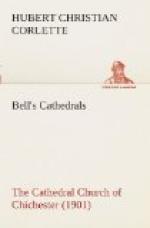Aethelwealh, grateful for Wilfrith’s aid, granted him lands at Selsea. The bishop at once gave freedom to those families and their slaves who occupied the district, and baptized them, giving them release, as Bede has told, from spiritual and temporal bond’s at the same time. Selsea thus became another see from which Christian principle and practice might be taught in the midst of the surrounding tribes. In this spot, near the residence of the king, a church was built, in which the bishop’s cathedra was placed. The structure was dedicated to S. Peter, and was the first cathedral church in Sussex. It is not now known what the architectural character of this building was. Perhaps there was some attempt in its design to take advantage of such suggestions as the Romans left behind them at Regnum, for we find in early instances of English architecture that such examples had exercised some influence upon the elementary efforts of those days. But it is more likely that his first church was nothing but a small and simple barn, for men were not then burdened with the idea that a cathedral must be a big church, provided it served as a centre from which the bishop could use his pastoral responsibility. During Wilfrith’s stay at Selsea many changes took place.
Then Ceadwalla, who had defeated Aedilwalch, or Aethelwealh, confirmed the grants to the Church made by his predecessor, in return for the kindness he had received from Wilfrith some time before.
Under their new head the missionaries at Selsea undertook, with the king’s sanction, to convert those who inhabited the neighbouring island of Wight and also parts of the mainland which now were subject to the new ruler. But after five years in the south Wilfrith returned to his old diocese of York. Sussex, to a large extent, had accepted the faith he endeavoured to teach, and many churches were established and organised before his departure.
[Illustrations: OUR LORD WITH MARTHA AND MARY. THE RAISING OF LAZARUS. SCULPTURED PANELS IN THE SOUTH CHOIR AISLE, SUPPOSED TO HAVE BEEN BROUGHT FROM THE CATHEDRAL AT SELSEA (SEE P. 96).]




